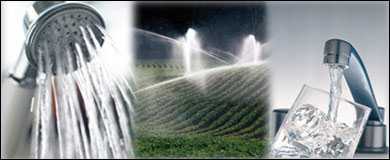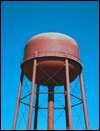NOTICE: This web page has been archived for historical purposes. Its content is no longer maintained, so information may be out of date and links may not work properly. For current Healthy Water features, please see the Newsroom, Features, & Observances page.
Ground Water Awareness Week
March 7 - 13, 2010

Did you know that much of the water you use comes from the ground? National Ground Water Awareness Week highlights the importance of this water source and encourages well owners to properly maintain their wells. Learn more about ground water, the threats to its safety and how to protect your own ground water sources.
 Clean water is one of the world's most precious resources. People use water every day for a variety of reasons, such as drinking, bathing, recreation, agriculture, cooling, and industry. Although water plays an essential role in every person's life, many individuals are not aware that much of their water comes from the ground in the form of ground water.
Clean water is one of the world's most precious resources. People use water every day for a variety of reasons, such as drinking, bathing, recreation, agriculture, cooling, and industry. Although water plays an essential role in every person's life, many individuals are not aware that much of their water comes from the ground in the form of ground water.
National Ground Water Awareness Week, an annual observance sponsored by the National Ground Water Association (NGWA), is March 7-13, 2010. The focus of this week is to stress the importance of yearly water testing and well maintenance. This year NGWA is asking people to pay particular attention to their well caps by proclaiming March 9th "National Inspect-Your-Well-Cap-Day" to encourage well owners to do this simple, yet essential, inspection (1).
Ground Water Contamination
Ground water is water that is located below the surface of the earth in spaces between rock and soil. Ground water supplies water to wells and springs and is a substantial source of water used in the United States. Thirty percent of all available freshwater comes from ground water (2), which supplies a significant amount of water to community water systems and private wells (3).
Protecting ground water sources from contamination is an important priority for countries throughout the world, including the United States. Most of the time, ground water sources in the United States are safe to use and not a cause for worry. However, ground water sources can become contaminated with bacteria, viruses, parasites, and chemicals that can lead to sickness and disease.
Ground water contaminants sometimes occur naturally in the environment (for example, arsenic and radon), but are more often the result of human activities. These activities include incorrect use of fertilizers and pesticides, poorly constructed or maintained septic systems, septic systems located too close to drinking water sources, improper disposal or storage of wastes, and chemical spills at industrial sites (4). From 1971â2006, 54% of reported drinking water outbreaks were due to the use of untreated ground water (31%) or ground water treatment deficiencies (23%). The most common pathogens identified in ground water outbreaks during this time period included Shigella spp., Hepatitis A, Norovirus, Giardia intestinalis, Campylobacter spp, and Salmonella spp (5).
 The presence of these contaminants in our drinking water can lead to health problems, including gastrointestinal illness, reproductive problems, and neurological disorders (6). Infants, young children, pregnant women, the elderly, and people whose immune systems are compromised because of AIDS, chemotherapy, or transplant medications may be especially susceptible to illness from certain contaminants. Concerns for ground water contaminants have led the U.S. Environmental Protection Agency (EPA) and individual states to develop new regulations to protect ground water in public systems (the Ground Water Rule).
The presence of these contaminants in our drinking water can lead to health problems, including gastrointestinal illness, reproductive problems, and neurological disorders (6). Infants, young children, pregnant women, the elderly, and people whose immune systems are compromised because of AIDS, chemotherapy, or transplant medications may be especially susceptible to illness from certain contaminants. Concerns for ground water contaminants have led the U.S. Environmental Protection Agency (EPA) and individual states to develop new regulations to protect ground water in public systems (the Ground Water Rule).
Is your household in either of these categories?
Are you among the almost 90 million Americans who get their tap water from a community water system that uses ground water?
 Seventy-eight percent of public water systems in the United States use ground water as their primary source, supplying drinking water to 30% of community water system users, or almost 90 million Americans (7). The U.S. Environmental Protection Agency (EPA) sets maximum concentration levels for many water pollutants and regulates drinking water quality in public water systems, including community water systems. You can find out more about your local drinking water quality and possible contaminants by viewing your consumer confidence report (CCR), which every utility company is required to provide to its customers.
Seventy-eight percent of public water systems in the United States use ground water as their primary source, supplying drinking water to 30% of community water system users, or almost 90 million Americans (7). The U.S. Environmental Protection Agency (EPA) sets maximum concentration levels for many water pollutants and regulates drinking water quality in public water systems, including community water systems. You can find out more about your local drinking water quality and possible contaminants by viewing your consumer confidence report (CCR), which every utility company is required to provide to its customers.
For more information on EPA's National Primary Drinking Water Regulations [PDF - 924.10 KB]
For more information on community water systems
Are you among the 15 million Americans households who use their own private wells?
 An estimated 15 million American households get their water from private ground water wells, which are not subject to EPA regulations (8). Private ground water wells can provide safe, clean water. However, well water can also become contaminated, leading to illness. It is the responsibility of the well owner to maintain and treat their well, in order to ensure their water is safe from harmful contaminants (9).
An estimated 15 million American households get their water from private ground water wells, which are not subject to EPA regulations (8). Private ground water wells can provide safe, clean water. However, well water can also become contaminated, leading to illness. It is the responsibility of the well owner to maintain and treat their well, in order to ensure their water is safe from harmful contaminants (9).
The National Ground Water Association (NGWA) recommends these steps for private well owners:
- Wells should be checked and tested ANNUALLY for mechanical problems, cleanliness, and the presence of certain contaminants, such as coliform bacteria, nitrates/nitrites, and any other contaminants of local concern, such as arsenic and radon.
- Inspect your well cap regularly. Your well cap protects against the entry of pollutants, such as runoff from pesticides, herbicides, soil erosion and street pollution, which constitute the majority of ground water contamination. Make sure the well cap is sealed tightly and look for cracks or evidence of tampering. Always use a qualified well systems contractor to fix any problems.
- Well water should be tested more than once a year if there are recurrent incidents of gastrointestinal illness among household members and/or a change in the taste, odor, or appearance of the well water.
- All hazardous materials, such as paint, fertilizer, pesticides, and motor oil, should be kept far away from your well.
- When mixing chemicals, do not put the hose inside the mixing container as this can siphon chemicals into a household's water system.
- Consult a professional contractor to verify that there is proper separation between your well, home, waste systems, and chemical storage facilities.
- Make sure that the top of your well is at least one foot above the ground.
- Once your well has reached its serviceable life (approximately 20 years), have a licensed or certified water well driller and pump installer decommission the existing well and construct a new one.
Source: Wellowner.org
More Information
- For information on private wells:
- For information on well water treatment:
- For information on well maintenance:
- For information on water wells, cap inspection and ground water stewardship:
- National Ground Water Association. National Ground Water Awareness Week: March 7-13, 2010.
- USGS. Earth's Water Distribution. Updated October, 2009.
- U.S. Environmental Protection Agency. Public Drinking Water Systems: Facts and Figures. Updated September, 2009.
- U.S. Environmental Protection Agency. Drinking Water from Household Wells; 2002 [PDF - 1.61 MB].
- CDC. Waterborne-Disease Outbreak Surveillance System, unpublished data 2010.
- U.S. Environmental Protection Agency. Drinking Water Contaminants. Updated September, 2009.
- U.S. Environmental Protection Agency. Factoids: drinking water and ground water statistics for 2008. Updated January, 2009.
- US Census Bureau. Current Housing Reports, Series H150/07, American Housing Survey for the United States: 2007, U.S. Government Printing Office, Washington, DC: 20401, Printed in 2008 [PDF - 6.82 MB].
- U.S. Environmental Protection Agency. Private Drinking Water Wells: What You Can Do. Updated August, 2009.
Get email updates
To receive email updates about this page, enter your email address:
Contact Us:
- Centers for Disease Control and Prevention
1600 Clifton Rd
Atlanta, GA 30333 - 800-CDC-INFO
(800-232-4636)
TTY: (888) 232-6348 - Contact CDC–INFO
 ShareCompartir
ShareCompartir


